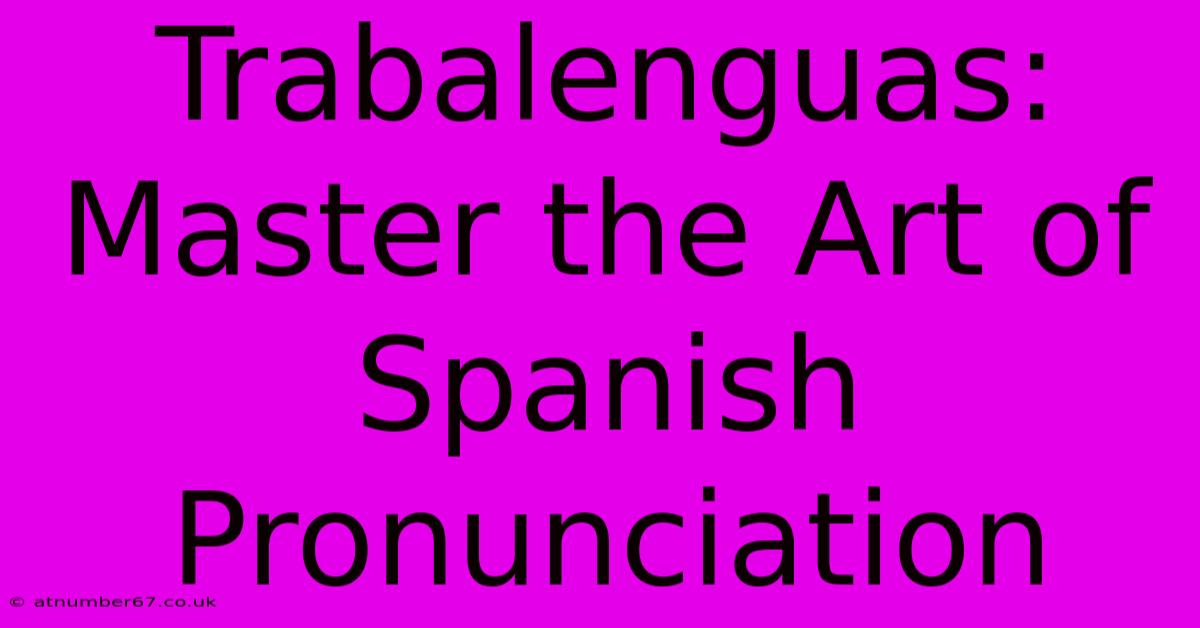Trabalenguas: Master The Art Of Spanish Pronunciation

Table of Contents
Trabalenguas: Master the Art of Spanish Pronunciation
Learning a new language is a rewarding journey, but mastering pronunciation can often feel like a monumental task. Spanish, with its beautiful sounds and rhythmic flow, presents its own unique set of challenges. However, one fun and effective method to conquer these challenges and improve your Spanish pronunciation is through the use of trabalenguas, or tongue twisters.
What are Trabalenguas?
Trabalenguas are essentially Spanish tongue twisters, designed to help speakers practice tricky sounds and improve their articulation. They're playful, often silly, and incredibly effective for honing your pronunciation skills. By repeatedly practicing these phrases, you'll strengthen your mouth muscles and develop the necessary dexterity to produce sounds accurately. This isn't just about memorization; it's about developing muscle memory for accurate pronunciation.
The Benefits of Using Trabalenguas
Beyond the obvious fun factor, incorporating trabalenguas into your Spanish learning routine offers a multitude of benefits:
-
Improved Pronunciation: This is the primary benefit. By tackling challenging sounds within the context of a tongue twister, you'll gradually improve your ability to articulate them clearly and correctly.
-
Increased Fluency: Repeated practice builds confidence and speed. As you become more comfortable with the sounds, your fluency will naturally increase.
-
Enhanced Vocabulary: Many trabalenguas incorporate useful and common vocabulary words, subtly expanding your lexicon as you practice.
-
Fun and Engaging Learning: Learning a language shouldn't be a chore. Trabalenguas provide a lighthearted and entertaining approach to mastering pronunciation.
-
Develops Ear Training: As you practice, you'll become more attuned to the subtle nuances of Spanish sounds, helping you to recognize and correct your own errors.
Popular Trabalenguas and How to Use Them
Let's explore some popular trabalenguas and discuss effective strategies for using them:
Easy Trabalenguas for Beginners:
-
"Pablito clavó un clavito, ¿qué clavito clavó Pablito?" (Pablo hammered a little nail, what little nail did Pablo hammer?) This focuses on the "cl" sound.
-
"Tres tristes tigres tragaban trigo en un trigal." (Three sad tigers were eating wheat in a wheat field.) This focuses on the repetition of "tr" sounds.
-
"El perro de San Roque no tiene rabo, porque Ramón Ramírez se lo robó." (The dog of San Roque doesn't have a tail because Ramón Ramírez stole it.) This is great for practicing the "r" sound.
Intermediate and Advanced Trabalenguas:
-
"Si quieres ser un buen corredor, corre y corre sin cesar." (If you want to be a good runner, run and run without stopping.) This tests speed and articulation.
-
"El cielo está enladrillado, ¿quién lo desenladrillará? El que lo desenladrillara, buen desenladrillador será." (The sky is bricked, who will unbrick it? He who unbricks it, will be a good unbricker.) This is a challenging twister with multiple difficult sounds.
How to use them effectively:
-
Start slowly: Focus on clear pronunciation, even if it's slow at first.
-
Record yourself: Listen back to identify areas for improvement.
-
Practice regularly: Consistency is key. Even short, daily practice sessions are more effective than infrequent, longer ones.
-
Vary your pace: Start slowly and gradually increase your speed as you gain confidence.
-
Have fun! The more you enjoy the process, the more effective your learning will be.
Incorporating Trabalenguas into Your Learning Strategy
Trabalenguas can be easily integrated into your existing Spanish learning routine. Try incorporating them into your daily practice:
- Warm-up: Start your study session with a few trabalenguas to loosen your tongue and prepare for pronunciation practice.
- Cool-down: End your session with a few more to reinforce what you've learned.
- Practice breaks: Use them during study breaks to refresh your mind and keep things fun.
- Share with others: Practice with a language partner or tutor to get feedback and make the learning process more social.
By embracing the playful challenge of trabalenguas, you'll not only significantly improve your Spanish pronunciation but also enhance your overall fluency and enjoyment of the language learning journey. So, roll up your sleeves, prepare your tongue, and get ready to conquer those tricky sounds! ¡Buena suerte! (Good luck!)

Thank you for visiting our website wich cover about Trabalenguas: Master The Art Of Spanish Pronunciation. We hope the information provided has been useful to you. Feel free to contact us if you have any questions or need further assistance. See you next time and dont miss to bookmark.
Featured Posts
-
The Impact Of Ranya Raos Age On Her Achievements
Apr 03, 2025
-
Pote Age Inspire Others Live Your Dream
Apr 03, 2025
-
Antigens A Beginners Guide To Immunity
Apr 03, 2025
-
The Irresistible Charm Of Ripped Mom Jeans
Apr 03, 2025
-
Captain Toms Daughter An Inspiring Example
Apr 03, 2025
